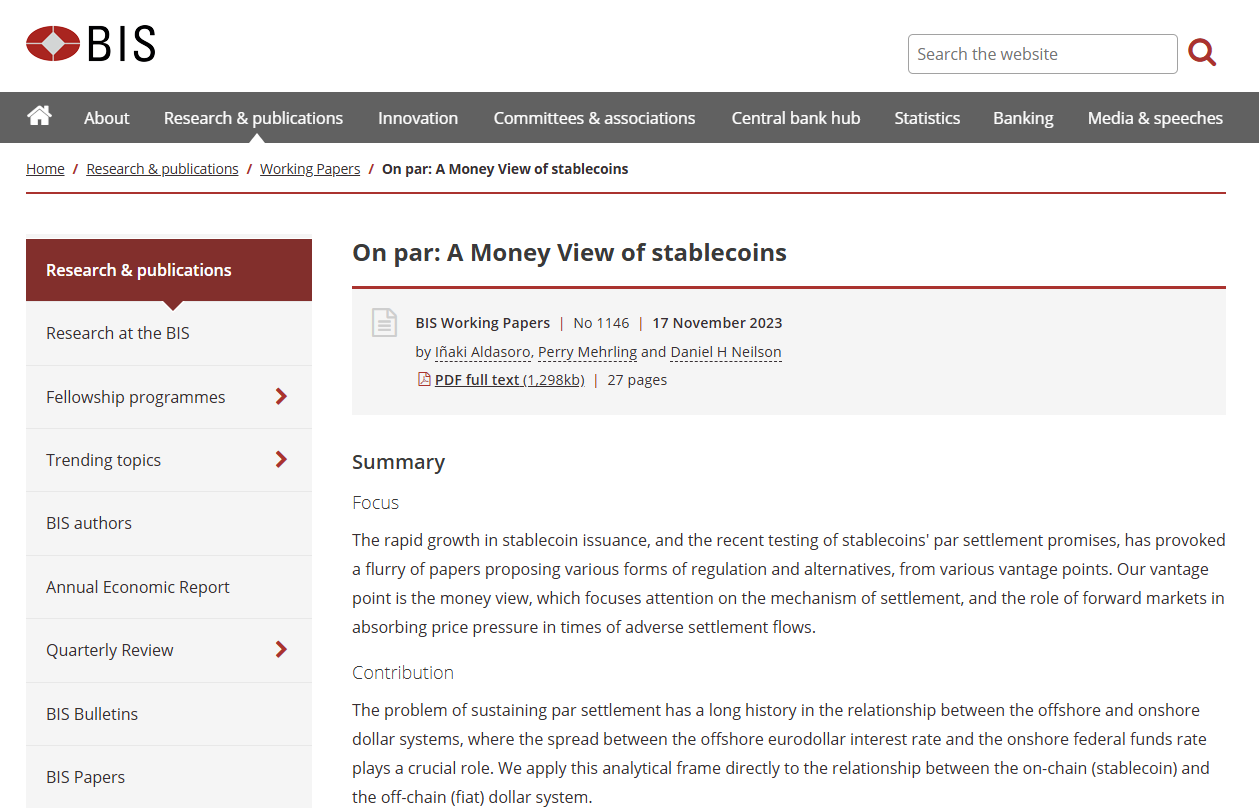
In an era of rapid financial innovation and intensifying geopolitical competition, the very nature of money and its control is being reshaped. The present issue features two articles of particular interest by two of our collaborators: the Italian MMT analyst Fabio Bonciani and the Chinese geopolitical expert Xiaoguang Yin. Both authors explore this intricate terrain, centring their analyses on stablecoins and the recently enacted GENIUS Act, which was signed into law by the U.S. President, Donald Trump.
Both pieces acknowledge the growing strategic importance of stablecoins and the U.S. government’s move to regulate them through the GENIUS Act, a legislative effort driven by Donald Trump within the broader context of U.S.-China economic rivalry. However, they diverge sharply on the fundamental implications of these developments, inviting us to question deeper truths.
Bonciani’s perspective argues that stablecoins, despite regulatory attempts to stabilize their value, are not true money but merely „financial assets“. This view suggests the Act is another „fraud“ perpetuating a false narrative about money’s scarcity, rather than adding real value to the economy.
Conversely, Yin’s analysis provocatively labels stablecoins as „the cancer of banks“. This perspective asserts that Trump’s true motive behind promoting stablecoins and the GENIUS Act is to strategically weaken the U.S. banking industry and reclaim the right to issue dollars from the Federal Reserve, which is described as a private entity controlled by wall street. Furthermore, it suggests stablecoins are a tool in a new „currency war“ to attack China economically by facilitating capital flight.
These narratives present a fascinating dichotomy: are stablecoins a deceptive tool hindering our understanding of sovereign money, or are they a disruptive force designed to dismantle established financial power structures and serve as a weapon in global economic warfare?
We invite you to immerse yourselves in these two distinct yet interconnected viewpoints. What do these differing interpretations reveal about the future of money, the role of states, and the unseen battles for financial dominance? Join the conversation and share your insights below.
2025/08/10 – by
US President Trump recently signed the Genius Act, which clearly articulates the US’s strategic intention to develop stablecoins.
Simultaneously, China announced a pilot program for a RMB stablecoin in Hong Kong. These steps indicate that a currency war between China and the US over stablecoins is underway.
There was a popular saying in the cryptocurrency world: stablecoins are the cancer of banks. This saying profoundly reveals the essence of stablecoins.
Why do people in the cryptocurrency world say this? To understand this, we need to start with the essence of stablecoins.
Stablecoins are a type of cryptocurrency whose payments and settlements occur on the blockchain.
The blockchain uses encryption algorithms and distributed technology to ensure its security and anonymity. Therefore, stablecoins, like other cryptocurrencies, have transaction anonymity.
Stablecoins differ from other cryptocurrencies in that they are pegged to valuable assets, hence the name.
According to the US Genius Act, stablecoins issued within the US must be pegged to assets such as the US dollar and US Treasury bonds at a 1:1 exchange rate.
In other words, $1 of a stablecoin (USDT, USDC, etc.) is backed by $1 worth of US Treasury bonds.
From this point on, the US dollar stablecoin began to become a cancer for banks. This cancer is not a metaphor, but a real cancer.
Having written this, I have to quote the analysis of stablecoins by American economist Perry Mehrling. In the report on stablecoins written by him and others for BIS, „On par: A Money View of stablecoins“, he conducted a detailed analysis of stablecoins.

Simply put, according to Mehrling, stablecoins will have a „balance sheet shrinking“ effect on the traditional banking system, especially when stablecoin companies (such as Tether and Circle) purchase US Treasury bonds to issue dollar-denominated stablecoins (such as USDT and USDC).
This is because US law stipulates that one dollar of a stablecoin can only be backed by one US Treasury bond. Unlike commercial banks, stablecoins cannot „create bank deposits out of thin air.“ Traditional commercial banks can „amplify“ central bank reserves through the so-called „money multiplier“ by extending loans, but stablecoin companies do not have this „privilege.“
More importantly, stablecoin companies purchase US Treasury bonds at the Federal Reserve (because they need to transfer funds to the US Treasury’s account at the Fed to purchase US Treasury bonds), rather than at traditional commercial banks.
Therefore, when stablecoin companies purchase US Treasury bonds to issue stablecoins, the Federal Reserve’s reserves decrease, which is the „balance sheet shrinking“ effect.
If the Federal Reserve’s reserves were to decline to a certain level (e.g., below $3 trillion), it would create a serious crisis for commercial bank transfers. This is because commercial banks rely on the transfer of central bank reserves, rather than simply transferring funds from one commercial bank to another.
As stablecoins continue to be issued, the Federal Reserve’s reserves would continue to decline. Once they reach a certain level, it would trigger a crisis for traditional commercial bank transfers, leading to a wave of bank failures.
This is why the cryptocurrency world calls stablecoins „the cancer of banks.“
It is already clear that the so-called „genius bill“ signed by Trump and the stablecoin it promotes will obviously pose a serious threat to the financial security of commercial banks and even tens of thousands of depositors in the banks.
But Trump doesn’t care about this, because his goal is to take back the right to issue US dollars from the Federal Reserve controlled by Wall Street.
We all know that the Federal Reserve, established in 1913, controls the issuance of the world’s most powerful currency, the US dollar.
However, few people are aware that the Federal Reserve is not a federal government agency but a private corporation. Its monetary policy is controlled by the 12 regional banks, with the Federal Reserve Bank of New York being the undisputed leader.
Of course, the shareholders behind these Federal Reserve regional banks are Wall Street financial power groups such as JPMorgan Chase, Citigroup, and Bank of America.
Therefore, the US dollar, which circulates freely around the world, is not controlled by the US government or the US president at all. It is only in the hands of Wall Street, which is not bound by any democratic procedures. Many US presidents have paid their precious lives in order to compete with Wall Street for control of the US dollar, including President Kennedy.
After President Kennedy came to power, to fight against the private Federal Reserve and regain the right to issue US dollars, he signed the little-known Presidential Order No. 11110. This order instructed the US Treasury to use silver to issue silver dollars to compete with the US dollars issued by the Federal Reserve.
President Kennedy’s counterattack plan certainly touched the interests of the financial power groups on Wall Street. In a rage, these Wall Street tycoons brazenly killed President Kennedy in full view of the public. For Wall Street, killing President Kennedy was not an assassination, but more like a public execution aimed at warning those who dared to confront Wall Street.
This time, Trump has returned with a lot of public support in his second term. Of course, he cannot let Wall Street go, because if Trump wants to implement his „grand plan“ of „making America great again“, he must take back the right to issue US dollars.
However, a direct attack on the Federal Reserve is obviously not feasible, as it may anger Wall Street and bring about fatal disasters. Therefore, Trump had to use a backup plan, which is to fight against the Federal Reserve by vigorously supporting stablecoins.
Trump keenly observed the huge development potential of stablecoins and cleverly linked the issuance of stablecoins to U.S. Treasury bonds.
In this way, stablecoin companies will purchase a large amount of U.S. Treasury bonds in order to issue stablecoins. The act of purchasing U.S. Treasury bonds will reduce the Federal Reserve’s reserves and trigger a crisis in the U.S. banking system.
Trump wants to use stablecoins to harm the U.S. banking industry as a bargaining chip and force Wall Street to hand over the Federal Reserve’s currency issuance rights to Trump.
Of course, the Wall Street giants, who have fought their way through centuries of blood and gore, will not surrender so easily.
They have strongly responded to Trump’s plan. According to the latest news, JPMorgan Chase has brazenly closed Trump’s account with them, and other major New York banks have refused to provide banking services to Trump.
The ostensible reason is to „prevent money laundering and other illegal activities,“ but the real reason is, of course, that Trump’s stablecoin has seriously harmed Wall Street’s interests.
The conflict between Trump and Wall Street has reached a fever pitch, and the war between the two sides is likely to continue.
In addition to regaining the right to issue US dollars, the main purpose of Trump’s second term is to launch a tariff war. The fundamental purpose of Trump’s tariff war is to bring manufacturing back to the United States and complete the so-called „Make America Great Again“ strategy.
As the world’s most powerful manufacturing country, China naturally became Trump’s main target.
Therefore, upon the start of his second term, Trump immediately deployed tariffs against China. However, the consequences were as we all witnessed: the US 10-year Treasury bond surged to a dangerous 5%, nearly triggering a collapse of the US Treasury market.
Furthermore, China also cut off its supply of rare earths to the US. According to reliable sources, US military production has been severely impacted by this cut.
It is obvious that Trump’s conspiracy to force China to make concessions through a tariff war has completely failed. Therefore, in a rage, Trump once again launched a strategy to attack China, that is, the US dollar stablecoin.
The US dollar stablecoin can allow wealthy people in China to easily evade the Chinese government’s financial supervision and flee their assets overseas through the US dollar stablecoin. Doing so can maximize the impact on China’s asset prices and, at the same time, hit the Chinese government’s fiscal revenue, ultimately achieving the goal of defeating China through both fiscal and financial means.
What is even more worrying is that Trump’s crackdown strategy seems to be having a disturbing „effect“
According to unconfirmed reports, Paolo Ardoino, the CEO of Tether, the company that issues the USDT stablecoin, privately revealed that China has become the region with the largest growth in USDT, far exceeding that of the Middle East, Africa, and other regions.
This is truly astonishing. If this information is true, it means that China is under severe attack from USDT, which deserves high vigilance for all Chinese people.
From this incident, we can also see that Trump is determined to defeat China and has a sinister plot to destroy China’s economy. This is another example of Trump’s „maximum pressure“ on China.
Furthermore, we have to admit that the main battlefield of the new Sino-US currency war is in the field of stablecoins.
The war has already begun, although it is a war without gun smoke.
2025/08/06 – by (alias Fabio Bonciani)
For days now, all anyone talks about is the GENIUS Act — an acronym for „Guiding and Establishing National Innovation for“ U.S. — a law recently passed by the United States Government designed to regulate stablecoins, a category of cryptocurrencies conceived to maintain stable value.
Money, as we know, is everyone’s primary desire, because in an economy driven by state currencies, the need for money to satisfy our needs is a constant in our daily lives.
Unfortunately, rather than being used to exchange goods and services, money today is increasingly used as an instrument of power and control by those who possess enormous quantities of it against those who are instead forced to live within the cage of its scarcity. This social phenomenon thrives thanks to the fraud that politicians, the press, and the vast majority of economists perpetrate regarding the real nature of money itself, its issuance, and who is responsible for its creation.
Faced with the problem of money scarcity, with the majority of people decisively demanding greater availability, yet another fraud is being developed, orchestrated by those who command us. Specifically, with the recent introduction of cryptocurrencies, they want to create among people the illusion that bitcoin and its siblings are money. Or better yet, they want to make people believe that cryptocurrencies could be that additional quantity of money that our „damned“ rulers refuse to create for their people’s needs.
It is sufficient to understand reality, which confirms that to obtain crypto, one needs to give state currency in exchange, to understand that they are not money at all, but rather financial assets. Moreover, as demonstrated, many of them are also highly speculative in terms of volatility.
For cryptos to be money, they lack almost all three elements that characterize it: unit of account, store of value, and medium of exchange.
Cryptos do not represent a „unit of account“ at all, since their value, like every other good and/or asset, is measured in state currency. They certainly do not guarantee a „store of value,“ since their issuance is not backed by any underlying real asset, nor by guarantees provided by the issuing entity. Finally, while being marginally used as a medium of exchange on a voluntary basis, this function is not guaranteed by state law (legal tender). In essence, those who pay in cryptocurrency, without the consent of those who accept it, have not fulfilled payment according to the law.
Here, faced with this obvious truth, the powers that guide states face the problem of how to make what is not actually money appear to be money to the people!
Trump’s GENIUS Act falls squarely within this elitist objective. Indeed, it was specifically created to confer upon cryptos — stablecoins in this case — the quality of „store of value,“ guaranteeing their stability through legislative regulation that requires the issuing entity to back them with safe assets (for example, short-term U.S. Treasury securities).
Let’s be clear from the start: even when states manage through their laws to make stablecoins at least stable in value, they remain an additional payment method, like a credit card to put it simply, and do not assume the quality of money, understood as state currency. Just to be clear and wake up those who still dream of increased money availability in their accounts through crypto use: not one additional dollar will be added to the American economy with the measure just introduced by Trump.
The fact that stablecoin holders can presumably redeem coins at par and at will for cash, just like demand bank deposits and money market funds, does not increase their financial wealth by a cent. Such wealth, as we well know, is directly dependent on government spending policy.
Within the narrative, there are even supporters who claim that the rapidly expanding stablecoin market not only provides a faster and cheaper payment system, but can also serve as an important funding source to help alleviate the federal debt crisis, destined to destroy the economy if not controlled. Here we go beyond fraud. Convincing people that a financial instrument denominated in the currency of a state and regulated by the laws of that state can be a source of financing for those who issue that currency under a monopoly regime reaches levels of certified insanity. Much less can it be the solution to the „phantom“ debt crises of states that have been consistently presented to families and businesses for decades to justify the lack of money for governments.
Stablecoin usage has exploded in recent years. By March 2025, their total market capitalization reached $232 billion, a 45-fold increase from December 2019. Projections suggest this figure could reach $400 billion by year-end and even $2.8 trillion by 2028. Stablecoins Tether (USDT) and USD Coin (USDC) dominate the market, holding 86% of it. In 2024, stablecoins processed a transfer volume of $27.6 trillion (the total value of stablecoin transactions recorded on blockchains), surpassing the combined volume of Visa and Mastercard. Daily volumes could reach $300 billion in 2025.
Stablecoins offer faster and cheaper transactions and are used in 71% of cross-border payments in Latin America. Latin America and sub-Saharan Africa lead in stablecoin transfers for retail and professional clients, with annual growth exceeding 40%. Major banks and fintech companies are also integrating stablecoins or have launched initiatives in this area, including Bank of America, Wells Fargo, Stripe, JPMorgan, PayPal, and Société Générale.
Despite the name, however, stablecoins are not completely stable. They have faced liquidity crises and transparency issues and are vulnerable to bank runs. Hence the need for regulation. The 2025 GENIUS Act, signed on July 18, 2025, requires stablecoin issuers to be banks or approved non-bank entities, maintain 1:1 reserves in safe assets (e.g., U.S. Treasury securities, liquidity) subject to monthly verification, and comply with KYC (Know Your Customer) and AML (Anti-Money Laundering) regulations.
The Washington government’s attempt to regulate stablecoins has revived the CBDC theme, identifying Trump’s action as if it were a way to let central bank digital currency back in through the window, which the tycoon himself had pushed out the door with an executive order signed last January.
Here too, they try to mislead public opinion about what is a false problem: the privacy that would be lost with a „programmable“ currency with which the issuer can control or block its use. Making people believe that a decentralized issuance, such as that of stablecoins, as opposed to the centralized one in the case of CBDCs, is another fairy tale told to confuse the subject matter. Any digital currency is „programmable“ unless specifically protected from it, and most of our currency today is already digital, created on bank ledgers when they make loans.
The government can access private bank records under certain circumstances and certainly lacks no technological capability to monitor every financial move. So what blocks, in the Western world unlike what happens in China, the introduction of CBDCs? The answer is provided by Nobel laureate Krugman, in a July 22 Substack post titled „Has Brazil Invented the Future of Money?“
Krugman suggests that it is actually banks that fear CBDCs, because people would withdraw their funds from private bank accounts in favor of central bank accounts, eliminating banking intermediaries and their much higher fees. He refers to Brazil, which has a CBDC-like system called Pix, a sort of public Zelle where transactions settle in an average of three seconds, compared to two days for debit cards and 28 days for credit cards; and Brazilian authorities have mandated that Pix be free for individuals. It is used by 93% of Brazilian adults, compared to a mere 2% of Americans who use cryptocurrencies for trading.
In short, that economic and financial world equally divided between „naive“ and „ignorant“ in the matter competes to give their explanation of what are the real intentions underlying the introduction of the GENIUS Act. Among them, there are those who, following the usual crazy neoliberal ideas, indicate the measure as absolutely necessary to save the federal bond market, which is in serious difficulty due to the void left by disappointed foreign governments, who are dumping Treasury securities and „de-dollarizing“ in response to Western sanctions and U.S. tariffs.
The „fairy tale,“ however, doesn’t just hit many industry operators but also those like Senator Bill Hagerty (R-TN) — among the first sponsors of the GENIUS Act — who believe they can lead stablecoin issuers to become „the world’s largest holders of U.S. Treasury securities by 2030.“
Now, tell me, what changes for people and governments if U.S. debt securities are held by American or foreign banks, or by companies that issue cryptocurrencies?!
NOTHING! ABSOLUTELY NOTHING…
Even American Treasury Secretary Scott Bessent (billionaire hedge fund manager, editor’s note), perhaps more for personal convenience than real belief, considers stablecoins a strategic tool to „consolidate dollar supremacy.“
There are even those like professors Gary B. Gorton and Jeffery Y. Zhang who, invoking history, have compared Trump’s GENIUS Act to the National Bank Act of 1863 and 1864, with which then-President Lincoln supposedly resolved the debt crisis.
Today as then, the problem arising from „wild“ action by subjects authorized to issue financial products while passing them off as money, in order to accumulate money and then flee with the loot, is always solved by resorting to the one who is the sole creator under monopoly of currency, namely the State. This is further certification that the only money existing in our economic systems is currency issued by the State.
Lincoln’s National Bank Act then, like Trump’s GENIUS Act today, served only to stabilize the private credit system and not to finance the State, as many hope could happen with stablecoins.
As easily understandable, the federal bonds purchased at the time by banks to guarantee the money issued were not sufficient to finance government needs. After all, how is it possible that the government — sole provider of net money, representing the reserves with which the private sector then purchases securities — should rely on such money to finance itself! Government financing occurs when ministries spend money (created from nothing, editor’s note), which materializes precisely in the aforementioned reserves.
If we add that the bankers of that time, supported by Great Britain, demanded 24-36% interest on loans — usurious conditions that risked „recolonizing“ the United States through debt — it seems like reliving the film of today’s „farce“ with which even today, with the gold standard dead and buried, state debts are presented. President Lincoln avoided that paralyzing debt by returning to the American colonists‘ financing mechanism: government-issued paper money. With the Legal Tender Act of 1862, the Treasury issued $450 million in U.S. banknotes or greenbacks, fiat currency spent directly into the economy for soldiers, supplies, and contracts.
Today, thanks especially to the work of Warren Mosler, founding father of Modern Monetary Theory (MMT), we know well that for a sovereign state, there is no distinction between spending banknotes or electronic numbers and that public debt securities do not serve in any way to finance governments, but represent entirely the political choice to provide income to those who hold savings.
Returning to our days, the United States with a federal debt of $36.72 trillion and a growing interest burden expected to amount to almost $1 trillion for 2025, despite the numbers and catastrophe projected by the mainstream, impossible to occur as monopolists of the dollar, today’s American economy can be considered in the same situation as then. As Lincoln got out of it, Trump can get out the same way, without the need for tariffs or tools like cryptocurrencies, but simply by exercising the monopoly his government holds over the currency it issues.
If we look to the other side of the world at the main global economic competitor of the USA, China is going in the completely opposite direction to that of the Washington government regarding cryptocurrency support. The Beijing government has officially banned cryptocurrency trading, mining, and related services, citing financial risks, capital flight concerns, and environmental impacts. At the same time, the Chinese executive, alongside the People’s Bank of China and with support from the China Development Bank, the world’s largest public development bank, has implemented the deficit spending necessary to carry out massive infrastructure and development projects throughout the country.
This is how China doesn’t give a damn about the „moods“ of world leaders, starting from Trump’s demented tariff policy and ending with Brussels‘ insane austerity policies, which impose on their peoples not to consume in order to export production to those who today have decided (the USA, editor’s note) not to consume anymore.
If today we were to rank the world’s country leaders who best understand how modern monetary systems work, certainly Trump and the leaders of major European countries would not appear at the top of this ranking. While Xi Jinping and Vladimir Putin appear decidedly much more knowledgeable on the subject.










